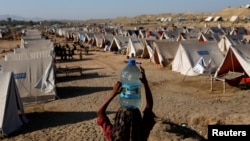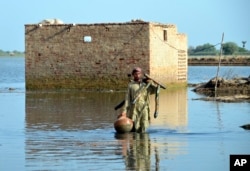The United States said Thursday it would give an additional $30 million in humanitarian aid to Pakistan to support victims of recent catastrophic flooding in the South Asian nation. It brings the total disaster-related assistance from Washington to Islamabad this year to $97 million.
U.S. Ambassador Donald Blome announced the new funding during a trip to southern Sindh province, one of the country's worst-hit regions.
"We have been here for the people of Pakistan since the beginning, supporting the most vulnerable communities. With these new funds, the United States will expand upon its existing response, enabling USAID to reach more than 1.8 million people in Pakistan," Blome said.
Pakistani and United Nations officials say torrential seasonal rainfall, made worse by global climate change, has triggered floods across Pakistan, affecting 33 million people and killing more than 1,700 others since June. Floodwaters destroyed or damaged 2.1 million houses, killed 1.2 million livestock, damaged 13,000 kilometers of roads, displaced 8 million people, including 644,000 living in relief camps, and drenched one-third of the country at one point.
A U.S. Embassy statement said the new funding would provide lifesaving food, nutrition, shelter supplies, winterization kits, and health assistance to mitigate increased food insecurity and malnutrition resulting from the impact of the floods. It will also support efforts aimed at curbing the rise of diseases resulting from stagnant flood waters, it said.
The United Nations said Thursday that 7% of the land in Pakistan is still inundated, warning health perils are changing with a rise in respiratory diseases.
"Water is receding, but now there's not enough water for [operating] rescue boats. This is increasing the number of areas which are inaccessible. People are returning to nothing," noted a U.N. statement. It lamented that people in hundreds of villages are surviving on fish from the water they drink, cook with, clean in, and defecate in.
The U.N. earlier this month increased its international humanitarian aid appeal to $816 million from $160 million for Pakistan after reviewing the scale of the disaster and fearing a surge in water-borne diseases, as well as growing food insecurity, could pose new challenges for the impoverished country.
The U.N. statement noted Thursday that 23%, or $110 million, has been committed to the appeal.
"Funding for food assistance may finish by the end of the year if more funds are not received. An estimated 14.6 million people require emergency food assistance from December through March 2023," the statement said. Almost 10 million children require immediate lifesaving support, while nearly 4 million lack access to health services, it added. "The shelter is becoming more and more important as people return home and winter sets in."
Nearly 2,000 health facilities have been damaged or destroyed in calamity-hit districts where more than 8 million people need health assistance. About 650,000 pregnant women in flood-affected areas face challenges in getting access to maternal services.
Pakistan officials have estimated damage from the flooding at about $40 billion, urging the global community to do more to provide financial aid to the country of about 220 million people.
Pakistan maintains that it produces less than 1% of global greenhouse gas emissions, but it is listed among the top 10 countries vulnerable to climate change-driven disasters.








